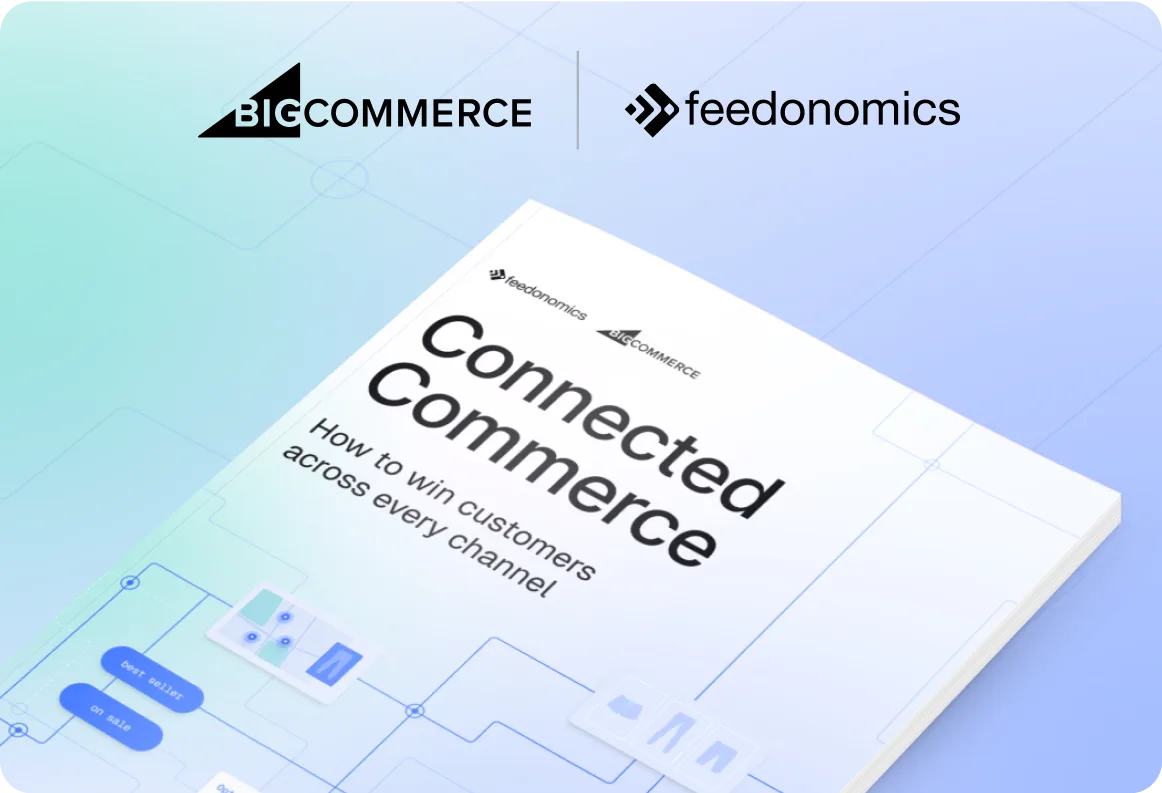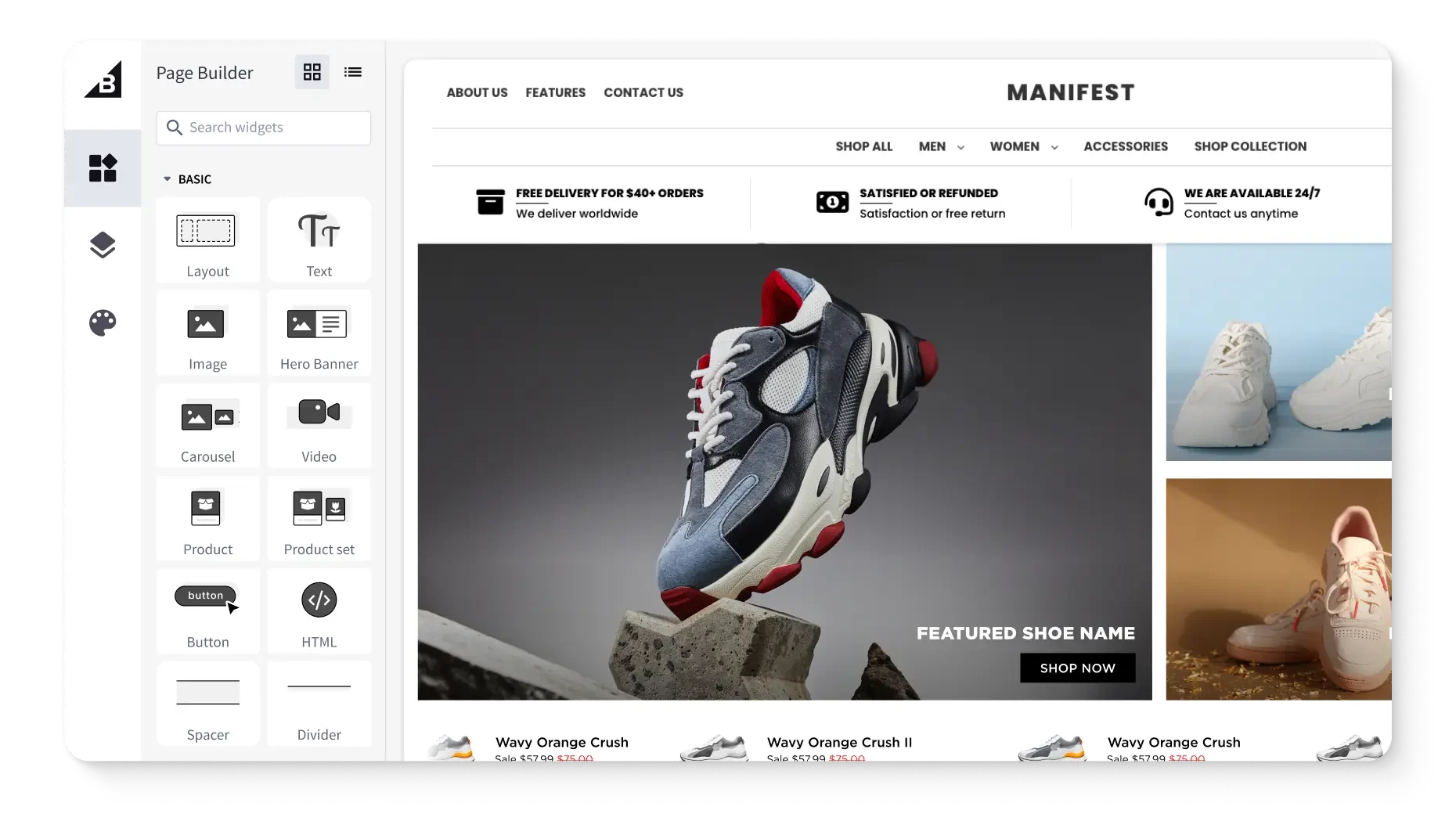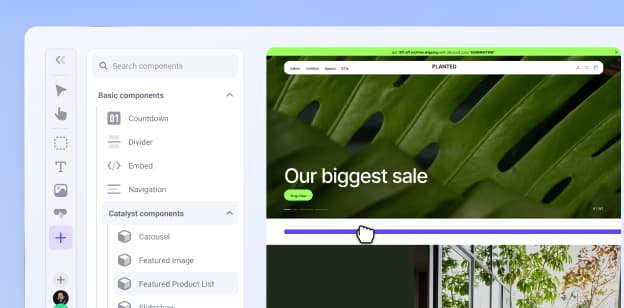
Ebook: Win Customers Across Every Channel
Get expert insights on data, branding, and marketing strategies to grow sales on every major ecommerce channel.
What you’ll learn:
Why online marketplaces are becoming essential to modern ecommerce strategy
How to expand your reach and revenue by selling across top marketplace platforms
What to expect from marketplace fees, including listing, commission, and final value fees
Which global and niche marketplaces offer the best opportunities for your product categories
How tools like BigCommerce and Feedonomics help automate, scale, and streamline online selling
More and more shoppers are skipping traditional stores and heading straight to online marketplaces.
Over half of consumers now buy from marketplaces at least a few times a month, and many shop them weekly. Whether it’s Amazon, AliExpress, or Rakuten, marketplaces have become the go-to for convenience, selection, and trusted experiences.
And the numbers back it up. By the end of 2025, third-party sales across the top 100 marketplaces will hit $3.2 trillion — a 10% increase from the year before.
For brands, the opportunity is massive. Online marketplaces make it easier to reach new customers, test new markets, and grow faster without reinventing your business model.
Benefits of selling on online marketplaces
Online marketplaces are more than just another sales channel. For fast-moving brands, they offer a powerful way to grow with less friction and more flexibility.
Fast to launch.
Most marketplaces are plug-and-play.
With the right integrations, like Feedonomics, a full-service feed management solution, you can list products, sync inventory, and start selling in a matter of days, not months.
This quick path to launch makes it easier to test new products, expand to new regions, or respond to demand without reworking your entire tech stack.
Massive customer reach.
Marketplaces are where the shoppers are.
Platforms like Amazon, Walmart, and TikTok Shop already have built-in audiences in the millions, or even billions. Selling through them helps brands meet customers where they already spend their time and money.
Allow you to scale and diversify your revenue streams.
Adding marketplaces to your omnichannel strategy spreads your risk and opens new growth paths.
You’re no longer limited to one storefront or one customer type. Instead, you can diversify across channels, products, and regions, helping you grow faster and more sustainably.
Access to analytics and insights.
Most marketplaces provide built-in reporting tools that surface customer behavior, sales trends, and conversion data.
These insights help you fine-tune listings, optimise pricing, and spot opportunities to grow, all without needing a separate analytics stack.
Top online marketplace examples
These leading marketplaces command massive reach, high engagement, and billions in product sales, making them key players in any omnichannel strategy.
Amazon.
Amazon leads all marketplaces by gross merchandise value, approaching $800 billion in 2024. Its scale, speed, and global fulfillment network continue to make it the top destination for both buyers and sellers.
Walmart.
Walmart ranks among the most visited ecommerce sites in the US, outpacing competitors like Target in traffic. Its marketplace continues to grow as more brands tap into its hybrid model of physical retail and digital reach.
Target Plus.
Target is investing heavily in its third-party marketplace. Target Plus has already reached $1 billion in sales, with a goal of growing into a $5 billion channel within the next five years. Its curated approach makes it a strong option for select brand partners.
eBay.
With 134 million active buyers and 2.4 billion listings, eBay remains one of the most established global marketplaces. Its auction-based roots now support a wide range of fixed-price listings across nearly every category.
Etsy.
Etsy’s community-driven platform has nearly doubled its active buyer base in recent years, jumping from 46 million in 2019 to about 95 million in 2024. It remains the go-to for handmade, vintage, and creative goods.
Instagram Checkout.
Instagram blends discovery and shopping seamlessly. In fact, 70% of its 2 billion users engage with shopping features, and checkout is built directly into the app — creating a frictionless path from inspiration to purchase.
TikTok Shop.
In 2024, about one in three US TikTok users made purchases directly from TikTok Shop. With shoppable videos and livestreams driving real-time buying behavior, TikTok continues to grow as a powerful commerce channel.
Facebook Shops.
Among consumers who shop through social platforms, nearly 10% say their most recent purchase came from Facebook Shops. Its deep integration with Meta's ad platform makes it a versatile option for brands looking to drive conversions.
Mercado Libre.
In Q2 2025, Mercado Libre saw 71 million unique buyers and facilitated over 550 million transactions — up 31% from the previous year. Its strong regional presence makes it the marketplace of choice across Latin America.
SHEIN Marketplace.
SHEIN has become the fastest-growing marketplace globally, with a projected growth rate of 87.8% in 2025. Known for speed and volume, it offers brands a direct path to trend-driven, value-focused shoppers.
Examples of Niche marketplaces
Niche marketplaces offer focused audiences, curated experiences, and targeted opportunities for category-specific brands.
Bonanza.
In August 2025, Bonanza saw over 1.1 million sessions, generating nearly $3.4 million in sales with an average order value between $200 and $225. Its lean model and seller-first approach make it a smart option for specialty brands.
Fruugo.
With $45 million in annual revenue in 2024, Fruugo continues to grow as a cross-border marketplace with a wide international reach and localised experiences for global shoppers.
Zalando.
Zalando has scaled its active customer base from 13.5 million to over 52 million since launching in 2014. Its mobile-first fashion marketplace remains a dominant force in Europe.
FullBeauty.
FullBeauty serves a growing market with nearly $1 billion in annual revenue and 5 million active customers. Its focus on plus-size fashion makes it one of the most established niche marketplaces in the US.
Tanga.
In August 2025, Tanga drove $1.6 million in revenue, far above its industry median. Known for deep discounts and a loyal deal-seeking audience, Tanga gives brands another path to value-conscious buyers.
Essential steps to leverage your online marketplace success
Getting your products listed is just the start. To turn marketplace visibility into long-term growth, brands need to operate efficiently, protect margins, and stay compliant.
Calculate profits: Understanding marketplace selling fees.
Every marketplace has its own fee structure, from referral percentages to subscription plans and fulfillment charges. These costs can vary by category, product type, and shipping method.
To stay profitable:
Review fee schedules before listing
Track total costs per sale, not just commissions
Adjust pricing to account for marketplace-specific expenses
Tools like Feedonomics can help you track performance at the SKU level, so you know exactly where your profits stand.
Diversify your shipping strategy: Meeting customer expectations.
Marketplace shoppers expect fast, affordable shipping, and they often compare sellers based on delivery speed.
To stay competitive:
Offer multiple shipping options, including expedited and economy
Use regional warehouses or third-party logistics providers (3PLs)
Consider marketplace fulfillment programs like Walmart Fulfillment Services or Fulfilled by Amazon
Giving customers more choices helps reduce cart abandonment and boost conversion rates.
Optimise fulfillment and logistics: Streamlining operations.
Accurate, efficient fulfillment is key to winning repeat customers and maintaining seller ratings.
To streamline your logistics:
Automate inventory tracking and order routing
Set clear return policies aligned with marketplace standards
Monitor fulfillment KPIs like delivery times, stockouts, and return rates
Operational consistency builds trust, and trust drives sales.
Scale with feed management software: Automating product listings.
Managing listings manually can become overwhelming as you expand to more marketplaces or add new SKUs.
Feed management platforms like Feedonomics allow you to:
Sync product data across channels automatically
Format listings to meet marketplace requirements
Optimise titles, descriptions, and attributes for discoverability
This reduces errors, improves product visibility, and frees up your team for higher-impact work.
Integrate with existing ecommerce platforms: Managing growth.
Managing sales in silos creates risk. Instead, unify your operations through integrations that keep everything in sync.
With BigCommerce, you can:
Connect your storefront to leading marketplaces
Centralise order management, inventory, and product updates
Avoid overselling or duplicate work across channels
This integration-first approach makes it easier to grow without complexity.
Know marketplace rules and regulations: Avoiding penalties.
Every marketplace has its own set of policies, and they can change quickly.
To stay compliant:
Regularly review seller guidelines
Watch for updates on shipping windows, content requirements, or product restrictions
Use automation to flag listing errors before they impact performance
Non-compliance can lead to listing suppression or even account suspension. Staying proactive protects your revenue.
Communicate with your customers: Announce your marketplace presence.
Your marketplace strategy shouldn’t stay behind the scenes. Let customers know where they can shop your products.
Ways to promote your marketplace presence:
Add marketplace badges or links to your website
Share product listings on social media
Include marketplace links in email campaigns or post-purchase flows
Consistent messaging builds awareness, boosts trust, and drives more traffic across all your sales channels.
How BigCommerce supports selling on marketplaces
BigCommerce gives brands the tools to manage, scale, and optimise their marketplace strategy, all from one unified platform. With built-in integrations and the power of Feedonomics, you can simplify operations and grow across every major channel.
Omnichannel management.
Selling on multiple marketplaces can quickly become complex. BigCommerce helps streamline your operations with centralised control over product data, listings, and order workflows, whether you’re selling on Amazon, Walmart, eBay, or Google.
With BigCommerce Channel Manager, you can:
Connect your storefront to leading marketplaces from one dashboard
Manage listings and inventory without switching between sites
Sync product updates and pricing across all connected channels
For growing businesses, Feedonomics provides a more advanced solution for product data optimisation and automation.
With Feedonomics, you can:
Push optimised product feeds to each marketplace
Tailor listings to meet channel-specific requirements
Sync product data and availability updates automatically
Together, these tools ensure consistency, improve discoverability, and reduce manual work, giving you more control across your omnichannel strategy.
Real-time inventory sync and order management.
Overselling leads to poor customer experiences and lost trust. BigCommerce keeps your inventory synced across marketplaces and storefronts in real time, so your stock levels and order data stay accurate.
With BigCommerce, you can:
Automatically update inventory with every sale
See all marketplace orders in one centralised dashboard
Adjust pricing or availability across all channels at once
For businesses managing high order volumes or large catalogs, Feedonomics extends these capabilities by syncing orders, routing fulfillment, and automating inventory reductions across channels.
This operational accuracy helps protect your seller ratings and ensures smoother fulfillment workflows as you scale.
Payment and shipping solution integrations.
BigCommerce supports a wide range of payment and shipping options, making it easier to meet marketplace requirements and customer expectations.
You can:
Accept credit cards, digital wallets, and local payment methods
Display real-time shipping rates from major carriers
Support multiple currencies and flexible address options at checkout
With these built-in integrations, you can offer a smooth, localised shopping experience across marketplaces, while maintaining control over how and where you fulfill each order.

Get a free 15-day trial of BigCommerce.
No credit cards. No commitment. Explore at your own pace.
The final word
Online marketplaces aren’t just another ecommerce trend, they’re where digital commerce is headed.
With billions in projected sales and a growing share of consumer attention, marketplaces offer brands a direct path to scale, visibility, and global reach. Whether you’re expanding to your first channel or managing a complex omnichannel strategy, the right tools make all the difference.
BigCommerce, along with Feedonomics, gives you the flexibility to connect, automate, and grow, all while staying in control of your customer experience.
The opportunity is massive. The infrastructure is here. Now is the time to make marketplaces part of your growth strategy.
Request a demo to see how BigCommerce can help you launch, manage, and scale across today’s top marketplaces.
FAQs about ecommerce marketplaces
The good news is that you don't have to handle it; technology does the job for you.
With the right data feed management software, the system handles your listings, syncs your data and ensures product accuracy.
Feedonomics manages complex integrations and catalog organisation while resolving feed errors in real-time. With state-of-the-art automation technology, you can unburden internal resources, knowing your data is safe and secure.
Simply put, online marketplaces are successful because they provide a centralised location for buyers and sellers to communicate and exchange goods.
To be more specific, an online marketplace like Amazon serves as a third party between three groups: distributors, suppliers, and customers.
By providing a platform that all three can use independently, the marketplace allows each to avoid the hassle of additional steps. The distributor focuses on distributing, the supplier on supplying and, of course, the customer on buying.
Like everything, the answer depends on many factors, including location, item distribution, and pricing.
If you are in the USA or Europe, Amazon is the most popular online marketplace.
However, if you're in Latin America, you're more likely to find success with a top online marketplace like Mercado Libre.
Similarly, popular options in the APAC region include:
Alibaba
Rakuten
Taobao
TMall
The Asia-Pacific region includes some of the most active marketplaces in the global ecommerce market. Notable examples include Shopee, Flipkart, Rakuten Japan, Amazon India, and Taobao. These platforms serve millions of buyers and support a wide range of product categories, from home improvement to fashion and electronics.
Each marketplace platform varies in its focus, but many are driven by third-party sellers offering both value and convenience to shoppers across the region.
In Europe, leading marketplaces include Zalando, La Redoute, Amazon Germany, and Otto. These platforms hold significant market share across categories like apparel, electronics, and quality products for the home.
Many European marketplaces prioritise curated experiences and localised logistics, especially important for small businesses expanding internationally. They're also ideal for brands looking to showcase high-quality goods to a growing base of mobile-first shoppers.
Mercado Libre dominates the Latin American digital marketplace space, with strong reach across countries like Mexico, Brazil, and Argentina. Amazon Mexico is also a key player.
These marketplaces serve a diverse range of product categories, from fashion and tech to home improvement. Latin America’s ecommerce growth is being driven by mobile adoption, third-party sellers, and increasing consumer demand for fast, trusted online selling experiences.
When selling on any popular marketplace, you’ll want to factor in several types of seller fees, including:
Final value fees (percentage of the sale)
Commission fees (based on product category or price)
Insertion fees or listing fees (for each item posted)
Subscription or account fees for premium features
Each marketplace platform has its own structure. For example, eBay charges final value fees, while Poshmark takes a flat cut from each sale. Tools like Feedonomics can help you track these fees and maintain healthy profit margins.
Selling through marketplaces gives you reach, but branding takes intention. To build your ecommerce business while using a digital marketplace, consider:
Including custom packaging or thank-you inserts
Offering a discount code for purchases on your ecommerce site
Using consistent visuals and product descriptions to reflect your brand voice
Choosing marketplace platforms that allow storefront customisation
Many third-party sellers use marketplaces as a lead-in to deeper customer relationships. By connecting marketplace traffic with your owned channels, you can grow both online sales and brand loyalty.

Online Marketplaces
Get The Print Version
Tired of scrolling? Download a PDF version for easier offline reading and sharing with coworkers.
A link to download the PDF will arrive in your inbox shortly.




